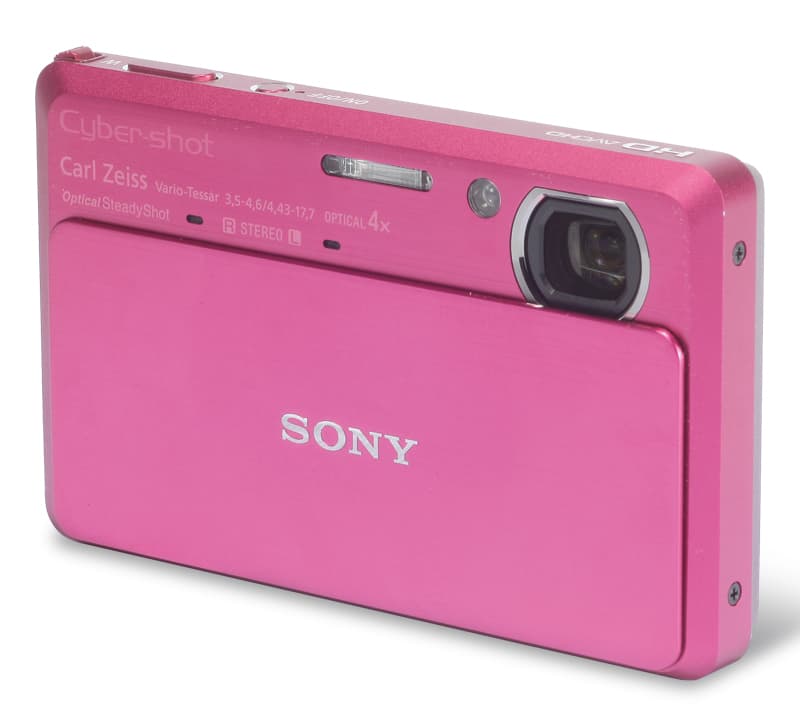Sony Cyber-shot DSC-TX9 review – Introduction
With a rise in 3D technology for digital viewing, we are beginning to see 3D included in digital cameras. Sony introduced 3D shooting modes to its NEX range with the NEX-3 and NEX-5 last year, and now for the first time it has incorporated it into a compact camera with the Sony Cyber-shot DSC-TX9.
Sony Cyber-shot DSC-TX9 review – Build and handling
Adding to Sony’s extensive range of slim and stylish T-series compact cameras, the Cyber-shot DSC-TX9 is well built, with a brushed metal-effect finish, and will slide comfortably into a pocket. It is available in a variety of colours; I was given a lovely pink one to test, sparking remarks from my friends. Access to the menus and controls is through the 3.5in, 921,600-dot LCD touchscreen, which is bright and punchy. As such, there are few buttons on the body, and all of these, including the zoom control, can be found on the top right above the screen. Start-up is initiated by sliding down the front panel. This reveals the built-in flash, assist light and the Carl Zeiss 25mm wideangle 4x optical zoom lens.
Operation relies on the touchscreen, which is responsive and easily navigated. The TX9 is a point-and-shoot camera with no control over aperture and shutter speed. However, there is control over white balance, ISO sensitivity (from ISO 125-3200), metering and focus areas, and ±2EV exposure compensation.
The Intelligent Auto (iAuto) adjustment mode automatically detects the scene and indicates on the display which mode has been selected. This should help new users to understand the best scene mode to use when choosing manually, which is just as well because the sheer volume of scene modes may bewilder users initially.
There are two 3D modes: sweep panorama and sweep multi angle. This is a first for a compact camera, and each makes use of the TX9’s fast frame rate of up to 10fps in high-speed burst mode. It shoots up to 100 images at the widest focal length and then stitches them together to form one large panorama. The 3D images can be displayed when used with a 3D TV.
I like the background defocus mode, which is designed for portraits. In this mode, the degree of blur can be adjusted and a soft-skin effect added in three levels. Also, among the several self-timer modes is a fun, auto self-portrait option. This detects when a self-portrait is framed and starts the timer without needing the shutter button to be pressed.
Video mode can be initiated quickly either through the touchscreen or via the button on the top of the body. An HDMi port is located on the bottom of the body for connecting the camera to a TV. Still and moving images can be viewed in-camera in several ways, including a calendar that shows what day images were taken, and a slideshow with accompanying music. However, I would have liked to see in-camera, post-capture editing for colour and contrast adjustments rather than just the tacky animations.
Performance and Verdict
Sony Cyber-shot DSC-TX9 review – Performance

The sweep panorama modes are effective for wide vistas and 3D sweep mode adds another dimension
Images are recorded on the 12.2-million-effective-pixel Exmor CMOS back-illuminated sensor and are crisp at lower sensitivities, although there are signs of smudging at ISO 400. This becomes more noticeable at ISO 800 and higher. However, the Cyber-shot DSC-TX9 has various settings to choose from to ensure less noise, including superior auto mode, which combines six images.
As I have come to expect from Sony Cyber-shot cameras, images have bright colour rendition and auto white balance is accurate in most situations. Focusing is responsive even in low light, and can be achieved by touching the desired part of the image on screen. Using the touchscreen is a breeze, and makes operation intuitive. The TX9 does not quite match other compact cameras in the same price range for image quality, but it does offer a vast array of features in a very slim body.
Despite the high asking price, this is a camera offering auto settings only. For the best part it quite simply does the job. Intelligent Auto is quick to adjust and selects scenes accurately. There are plenty of shooting modes to sink your teeth into, and the 3D modes are particularly good for wide vistas. I suspect that most users will hone in on a few preferred settings and generally stick to them for familiarity and speed, and they will not be perturbed by the iAuto function. The 1080i video mode is likely to please video users with crisp images, silent 4x optical zoom and stereo speakers.
Sony Cyber-shot DSC-TX9 review – Our Verdict
Such a high asking price is generally reserved for a serious camera with manual controls, not a point-and-shoot model like the TX9. However, it combines simple and intuitive operation with a host of genuinely useful features and shooting modes for all types of situation.







